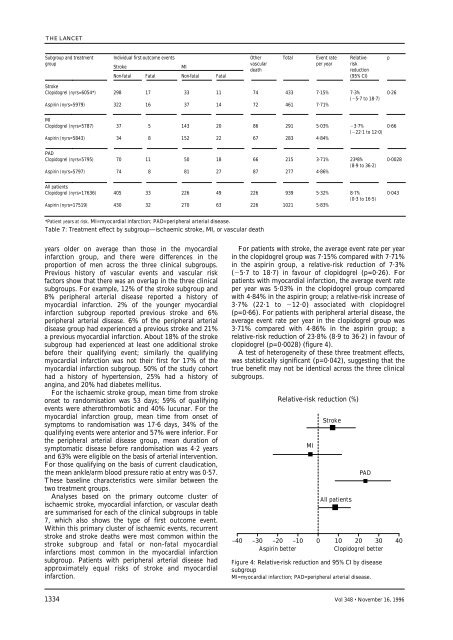A randomised, blinded, trial of clopidogrel versus aspirin in patients ...
A randomised, blinded, trial of clopidogrel versus aspirin in patients ...
A randomised, blinded, trial of clopidogrel versus aspirin in patients ...
You also want an ePaper? Increase the reach of your titles
YUMPU automatically turns print PDFs into web optimized ePapers that Google loves.
THE LANCET<br />
Subgroup and treatment Individual first-outcome events Other Total Event rate Relative- p<br />
group<br />
Stroke MI<br />
vascular<br />
death<br />
per year risk<br />
reduction<br />
Non-fatal Fatal Non-fatal Fatal<br />
(95% CI)<br />
Stroke<br />
Clopidogrel (nyrs=6054*) 298 17 33 11 74 433 7·15% 7·3%<br />
(5·7 to 18·7)<br />
0·26<br />
Aspir<strong>in</strong> (nyrs=5979) 322 16 37 14 72 461 7·71%<br />
MI<br />
Clopidogrel (nyrs=5787) 37 5 143 20 86 291 5·03% 3·7% 0·66<br />
(22·1 to 12·0)<br />
Aspir<strong>in</strong> (nyrs=5843) 34 8 152 22 67 283 4·84%<br />
PAD<br />
Clopidogrel (nyrs=5795) 70 11 50 18 66 215 3·71% 23ª8% 0·0028<br />
(8·9 to 36·2)<br />
Aspir<strong>in</strong> (nyrs=5797) 74 8 81 27 87 277 4·86%<br />
All <strong>patients</strong><br />
Clopidogrel (nyrs=17636) 405 33 226 49 226 939 5·32% 8·7% 0·043<br />
(0·3 to 16·5)<br />
Aspir<strong>in</strong> (nyrs=17519) 430 32 270 63 226 1021 5·83%<br />
*Patient years at risk. MI=myocardial <strong>in</strong>farction; PAD=peripheral arterial disease.<br />
Table 7: Treatment effect by subgroup—ischaemic stroke, MI, or vascular death<br />
years older on average than those <strong>in</strong> the myocardial<br />
<strong>in</strong>farction group, and there were differences <strong>in</strong> the<br />
proportion <strong>of</strong> men across the three cl<strong>in</strong>ical subgroups.<br />
Previous history <strong>of</strong> vascular events and vascular risk<br />
factors show that there was an overlap <strong>in</strong> the three cl<strong>in</strong>ical<br />
subgroups. For example, 12% <strong>of</strong> the stroke subgroup and<br />
8% peripheral arterial disease reported a history <strong>of</strong><br />
myocardial <strong>in</strong>farction. 2% <strong>of</strong> the younger myocardial<br />
<strong>in</strong>farction subgroup reported previous stroke and 6%<br />
peripheral arterial disease. 6% <strong>of</strong> the peripheral arterial<br />
disease group had experienced a previous stroke and 21%<br />
a previous myocardial <strong>in</strong>farction. About 18% <strong>of</strong> the stroke<br />
subgroup had experienced at least one additional stroke<br />
before their qualify<strong>in</strong>g event; similarly the qualify<strong>in</strong>g<br />
myocardial <strong>in</strong>farction was not their first for 17% <strong>of</strong> the<br />
myocardial <strong>in</strong>farction subgroup. 50% <strong>of</strong> the study cohort<br />
had a history <strong>of</strong> hypertension, 25% had a history <strong>of</strong><br />
ang<strong>in</strong>a, and 20% had diabetes mellitus.<br />
For the ischaemic stroke group, mean time from stroke<br />
onset to randomisation was 53 days; 59% <strong>of</strong> qualify<strong>in</strong>g<br />
events were atherothrombotic and 40% lucunar. For the<br />
myocardial <strong>in</strong>farction group, mean time from onset <strong>of</strong><br />
symptoms to randomisation was 17·6 days, 34% <strong>of</strong> the<br />
qualify<strong>in</strong>g events were anterior and 57% were <strong>in</strong>ferior. For<br />
the peripheral arterial disease group, mean duration <strong>of</strong><br />
symptomatic disease before randomisation was 4·2 years<br />
and 63% were eligible on the basis <strong>of</strong> arterial <strong>in</strong>tervention.<br />
For those qualify<strong>in</strong>g on the basis <strong>of</strong> current claudication,<br />
the mean ankle/arm blood pressure ratio at entry was 0·57.<br />
These basel<strong>in</strong>e characteristics were similar between the<br />
two treatment groups.<br />
Analyses based on the primary outcome cluster <strong>of</strong><br />
ischaemic stroke, myocardial <strong>in</strong>farction, or vascular death<br />
are summarised for each <strong>of</strong> the cl<strong>in</strong>ical subgroups <strong>in</strong> table<br />
7, which also shows the type <strong>of</strong> first outcome event.<br />
With<strong>in</strong> this primary cluster <strong>of</strong> ischaemic events, recurrent<br />
stroke and stroke deaths were most common with<strong>in</strong> the<br />
stroke subgroup and fatal or non-fatal myocardial<br />
<strong>in</strong>farctions most common <strong>in</strong> the myocardial <strong>in</strong>farction<br />
subgroup. Patients with peripheral arterial disease had<br />
approximately equal risks <strong>of</strong> stroke and myocardial<br />
<strong>in</strong>farction.<br />
For <strong>patients</strong> with stroke, the average event rate per year<br />
<strong>in</strong> the <strong>clopidogrel</strong> group was 7·15% compared with 7·71%<br />
<strong>in</strong> the <strong>aspir<strong>in</strong></strong> group, a relative-risk reduction <strong>of</strong> 7·3%<br />
(5·7 to 18·7) <strong>in</strong> favour <strong>of</strong> <strong>clopidogrel</strong> (p=0·26). For<br />
<strong>patients</strong> with myocardial <strong>in</strong>farction, the average event rate<br />
per year was 5·03% <strong>in</strong> the <strong>clopidogrel</strong> group compared<br />
with 4·84% <strong>in</strong> the <strong>aspir<strong>in</strong></strong> group; a relative-risk <strong>in</strong>crease <strong>of</strong><br />
3·7% (22·1 to 12·0) associated with <strong>clopidogrel</strong><br />
(p=0·66). For <strong>patients</strong> with peripheral arterial disease, the<br />
average event rate per year <strong>in</strong> the <strong>clopidogrel</strong> group was<br />
3·71% compared with 4·86% <strong>in</strong> the <strong>aspir<strong>in</strong></strong> group; a<br />
relative-risk reduction <strong>of</strong> 23·8% (8·9 to 36·2) <strong>in</strong> favour <strong>of</strong><br />
<strong>clopidogrel</strong> (p=0·0028) (figure 4).<br />
A test <strong>of</strong> heterogeneity <strong>of</strong> these three treatment effects,<br />
was statistically significant (p=0·042), suggest<strong>in</strong>g that the<br />
true benefit may not be identical across the three cl<strong>in</strong>ical<br />
subgroups.<br />
Relative-risk reduction (%)<br />
All <strong>patients</strong><br />
–40 –30 –20 –10 0 10 20 30 40<br />
Aspir<strong>in</strong> better<br />
Clopidogrel better<br />
1334 Vol 348 • November 16, 1996<br />
MI<br />
Stroke<br />
PAD<br />
Figure 4: Relative-risk reduction and 95% CI by disease<br />
subgroup<br />
MI=myocardial <strong>in</strong>farction; PAD=peripheral arterial disease.
















